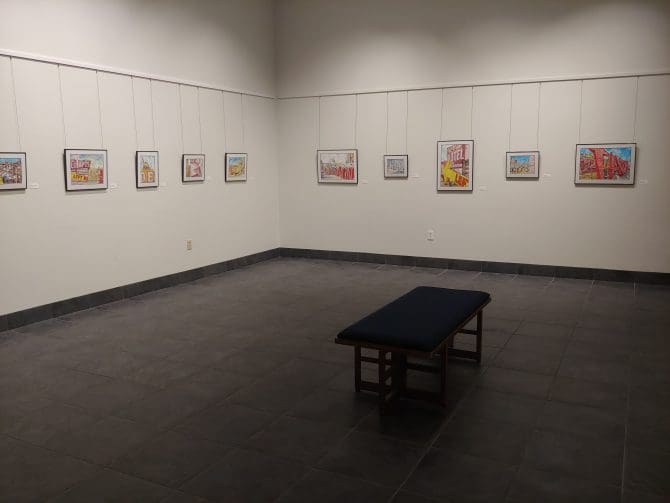
A collection of watercolor paintings depicting vintage Las Vegas signage from the Neon Museum Boneyard. Doug Waterfield, artist and University of Nebraska at Kearney art professor, sees the retired, faded, and rusting casino signs as reminders that life and its pleasures are temporal.
ARTIST STATEMENT
In 2013, I was able to visit the “Boneyard” of the Neon Museum, just north of Fremont Street in Las Vegas, NV. I spent the day photographing decaying signage and advertising mementos from the Golden Age of Las Vegas history. The signage preserved at the Boneyard proved to be a tangible link, a reminder of the atomic age that had permeated an earlier painting series of mine, DOOMTOWN. The images of DOOMTOWN were populated mostly by melting mannequins and mushroom clouds, but underneath it all was the idea of the domestication of the atomic bomb in the form of giant, mutated insects and irradiated monsters. America needed a way to forget the impending doom of Russia’s seemingly unflappable goal of leveling the US with atomic fire. Las Vegas held rooftop viewing parties and beauty contests, with showgirls dressed in atomic mushroom clouds. Las Vegas became a goal for people to forget their troubles, have a few drinks and watch a show. The lure of the neon was also a ticket to Sin City that often resulted in financial ruin for more than a few. But that’s not what we remember…
The glowing neon of the signs of classic Vegas served as a beacon, promising fun and enjoyment for all, and in all sorts of ways. It occurred to me that commemorating the signage in its current state, rusting and disintegrating in the desert was a powerful symbol, not only of America’s loss of innocence at the hands of the fear of global annihilation but also of some of the shortcomings of capitalism. The neon tubes will eventually break, and the light bulbs will go out. The paint will fade and the metal will rust. The promises of the casino signs, valid or not, would, like all things do, eventually, fade away. Life is temporal.
While this show of paintings looks back to the good old days, I hope it also serves as a reminder of how temporary the pleasures of the good old days might be. It is also a statement on how we as Americans are willing to suspend our beliefs, and our fears, as long as it takes to have a good time. Though they once were symbols of fun and potential winnings at the craps table, these rusting hulks of Las Vegas have become symbols of reality, and a reminder not to put too much stock in bright lights and vivid colors. Everything will, either quickly like an atomic bomb explosion, or slowly in the fading desert sunlight, fade away. All we will have are the memories.
That being said, I think there is also an overlooked beauty in these objects. I like to think that in addition to the obvious statements on the American love of excess, there is also nobility in finding beauty in unexpected places, even a broken light bulb. I think it’s important to stop and look at things and ponder their possibilities. I used unexpected juxtapositions and cropping to create what I felt were interesting compositions. The details of empty light bulb sockets, dusty advertising, and rust trails were challenging to capture, but also enjoyable me to transform into works of art. Beauty can be found just about anywhere if we are willing to take the time to look.
Doug Waterfield is a Professor of Art at the University of Nebraska at Kearney. His work has been shown at the United Nations Headquarters in Vienna, the National Atomic Testing Museum in Las Vegas, the National Museum of Nuclear Science and History in Albuquerque, the Los Alamos Historical Society Museum and the American Museum of Science and Energy. His work has also confused numerous patrons at various and sundry galleries, bars, souvenir shops, tattoo parlors and seedy dives across America.
He enjoys hobnobbing with the rich and infamous, watching terrible movies, world travel and collecting autographs. He hates lima beans, but loves good bourbon. He lives in Kearney with his long-suffering wife and three children. He is hell-bent on world domination through the creation of his own, personal army of robot super-men. He also owns 2 dogs with seven legs between them.
www.dougwaterfield.com
On exhibit at Summerlin Library from July 27 through October 3, 2021
Monday: 10:00 AM - 8:00 PM
Tuesday: 10:00 AM - 8:00 PM
Wednesday: 10:00 AM - 8:00 PM
Thursday: 10:00 AM - 8:00 PM
Friday: 10:00 AM - 6:00 PM
Saturday: 10:00 AM - 6:00 PM
Sunday: 10:00 AM - 6:00 PM





Add a comment to: Doug Waterfield: Viva Las Vegas